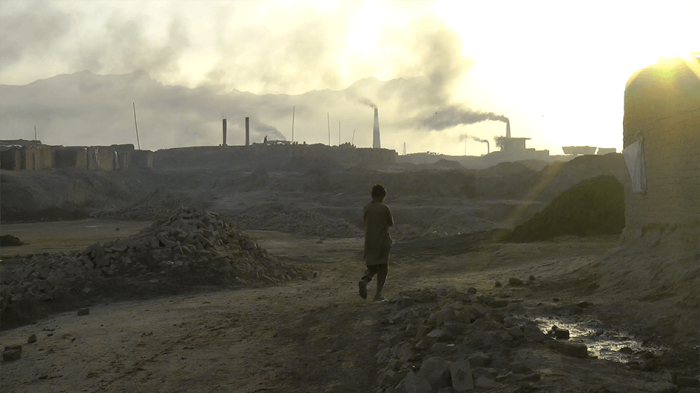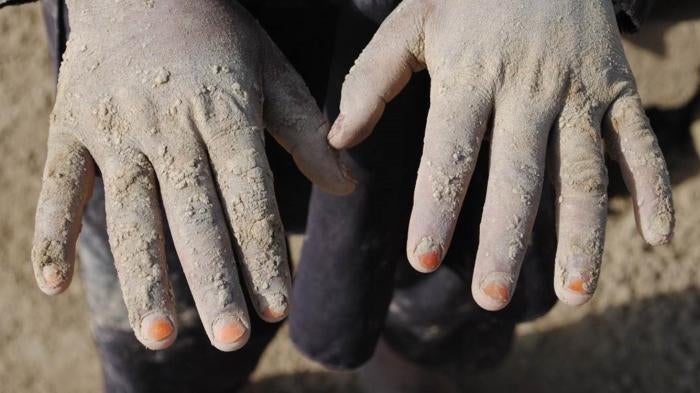Video: Kids at Work, Out of School in Afghanistan
Read a text description of this video
Azizullah
12-year-old carpet weaver
My name is Azizullah. I’m 12. I’ve been weaving carpets for about seven years. There are 11 of us brothers and sisters and we earn our living for our family through carpet weaving.
Ahmad Shuja
Researcher
Human Rights Watch
About a quarter of all Afghan children are engaged in child labor. These children work as carpet weavers on looms at home, they work in the metal works industry, they work as shoe shiners, as street workers. They work as bonded labor in brick kilns. Many of them work long hours under difficult circumstances doing work that is injurious to their health and could also cause death.
Sajjad
13-year-old metal worker
My name is Sajjad. I’m 13 years old. I get lots of cuts but one time the [metal] sheet cut my leg. The sheet was on the shop floor. When I was walking by, my leg got caught on it and I got a big gash.
Ali Eftekhari
Spokesperson
Ministry of Labor
Government of Afghanistan Children under the age of 18 are forced to work because of poverty and unemployment [of their parents.] 36% of the population in Afghanistan lives under the poverty line. A more serious problem is the lack of awareness among the people about the rights of children.
Ahmad Shuja
Researcher
Human Rights Watch
Under Afghan law, children between the ages of 15 and 17 are allowed to work provided that the work is less than 35 hours a week, represents a form of skilled training such as learning to be a tailor or metal smith, and the work is not physically harmful to the child. Children 14 or below working in any form of labor is illegal. But thousands of these children do work, often in circumstances that are harmful to their health and well-being.
Sayed Maroof Sadat
Principal
Muhammad Alam Faizzad High School, Kabul
Several years ago, one of our students worked as a mechanic. He was under a car when the jack gave way and he was killed instantly. His name was Haseeb. He was a graduate of year 12. These incidents happen, these accidents.
Ahmad Shuja
Researcher
Human Rights Watch
The carpet sector has one of the highest rates of child participation, particularly girls because it is a home-based industry and so girls find it easier to be employed inside of their own houses. And because it is a home-based industry, it is more difficult to regulate for the government.
Azizullah
12-year-old carpet weaver
I start at 5 in the morning and work until 6 at night.
Ahmad Shuja
Researcher
Human Rights Watch
Children working on the carpet looms face a lot of physical hazards. They risk having carpal tunnel syndrome, they risk diminishing vision, they risk cuts and injuries to their hands and to their eyes and they complain often of bodily ache because they sit in one straight posture for many long hours during the day.
Marina
15-year-old carpet weaver
Our eyes hurt and our hands also get injured.
Azizullah
12-year-old carpet weaver
My lower back hurts. It’s been seven years.
Marina
15-year-old carpet weaver
When I work too long, I inhale the dust so I get a cough.
Azizullah
12-year-old carpet weaver
When I breathe, the particles of yarn stick to my throat then I get a cough.
Ahmad Shuja
Researcher
Human Rights Watch
Children who work in brick kilns actually work in bonded conditions which means they have to work to pay off a debt that the family had incurred and often these children have absolutely no choice but to work on the brick kiln.
Rahimullah
15-year-old brickmaker
Every day we wake up with the mullah’s call to prayer. We start making bricks early in the morning and continue until evening.
Helal
10-year-old brickmaker
I don’t like making bricks. It hurts because the work is hard and the mold is heavy. We take chunks of clay from the mound and our hands hurt.
Ahmad Shuja
Researcher
Human Rights Watch
Basically in brick kilns, as soon as a child is able to walk and do things, they’re enlisted to work.
Shafiullah
Brickmaker
By the grace of God, I have 11 children. This one brings us sand. This one turns over the bricks. When they turn five, they start working. That’s when they start. The point is everyone works.
Ahmad Shuja
Researcher
Human Rights Watch
Children who work often are not able to go to school, and if they do go to school they’re forced to combine the difficult burden of labor and of education. Therefore, a lot of children are often forced to quit school because they work.
Helal
10-year-old brickmaker
There are schools but we don’t go to them. We make bricks here.
Arefa
19-year-old carpet weaver
We go to school about four or five hours. The rest of the day, we’re here. The stress from carpet weaving distracts us from our education. If you weren’t weaving carpets, what would you prefer to do?
Marina
15-year-old carpet weaver
I would continue my studies and attend courses.
Ahmad Shuja
Researcher
Human Rights Watch
Children who work have the right to safety, physical well being, the right to emotional well-being, the right to an education. The Afghan government needs to implement its laws regulating children and prohibiting them from working under difficult and harmful circumstances. The government needs to hire more labor inspectors, needs to train them and to legally empower them, to identify and then to rectify instances of children involved in harmful work. The international community needs to help the Afghan government offer technical expertise to devise regulations, policies and laws to combat child labor and to offer the financial assistance to the government to run programs of social support for childrensuch as education, healthcare, counseling and legal aid.
Ali Eftekhari
Spokesperson
Ministry of Labor
Government of Afghanistan
Unfortunately, we don’t even have the minimum budget for social support programs. This is mostly because the national budget is spent on security and less on social issues such as vulnerable children. For example, if we prohibit children from working, we must at least have an alternative plan to support them [to say] for example, “you should not be working, we will support your family, either financially or by providing them jobs.” Unfortunately, we have a problem in this area.
Ahmad Shuja
Researcher
Human Rights Watch
If the Afghan government fails to address of child labor, a quarter of Afghan children is going to grow up with basically no or very little education so these children will not be able to escape the cycle of chronic poverty during their lifetime.
Rahimullah
15-year-old brickmaker
We want to go away from the brick kiln and go somewhere else and have a decent life. For my brothers and sisters to go to school. We want to go to school and learn a new skill. There is no future in brick making.
In Afghanistan, tens of thousands of children work dangerous jobs in the country's carpet industry; as bonded labor in brick kilns; and as metal workers.
Extreme poverty often drives Afghan children into hazardous labor. Afghanistan remains one of the poorest countries in the world. Landlessness, illiteracy, high unemployment, and continuing armed conflict in much of the country are among the most importantfactors contributing to chronic poverty and, as a result, child labor.

